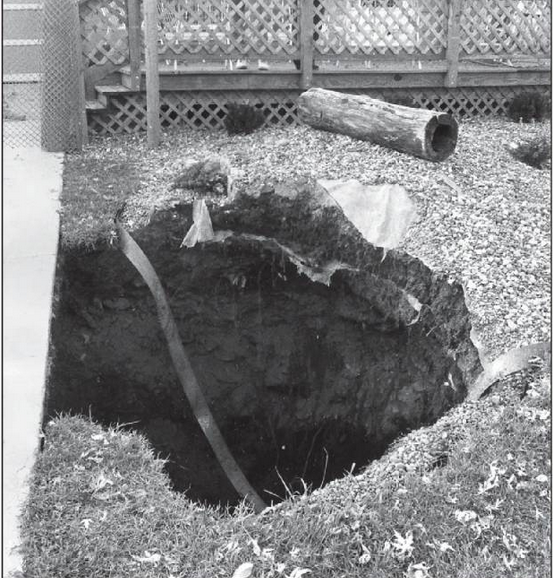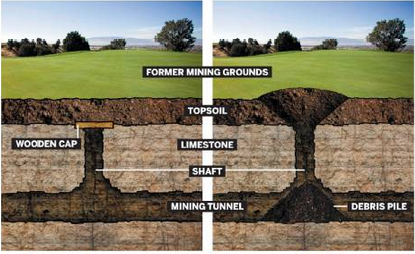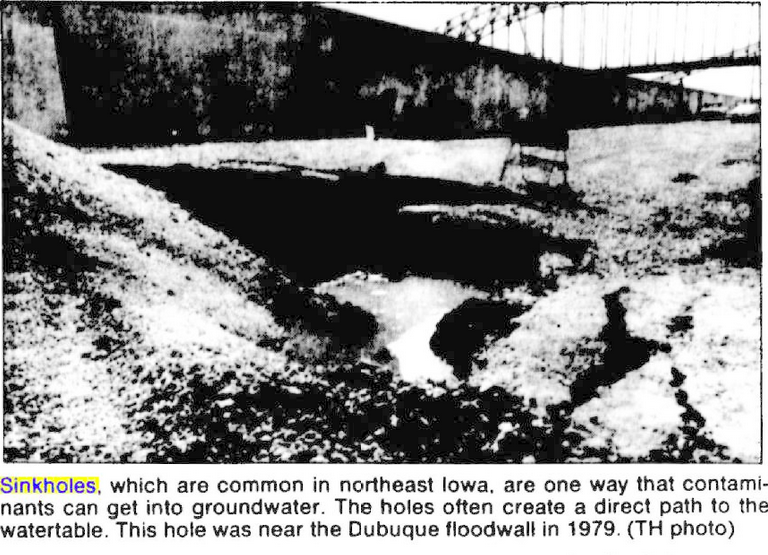Encyclopedia Dubuque
"Encyclopedia Dubuque is the online authority for all things Dubuque, written by the people who know the city best.”
Marshall Cohen—researcher and producer, CNN
Affiliated with the Local History Network of the State Historical Society of Iowa, and the Iowa Museum Association.
SINKHOLES
SINKHOLES. Two types of sinkholes, technically called "mining subsidences" exist. A mining subsidence is a movement of the ground surface caused by the collapse or failure of underground mine workings. )1) One forms when the roof of a cave collapses and exposes the underground cavern. The second type forms when water dissolves the rock underneath soil and creates an underground chasm. Without rock to support it, the soil layer collapses and creates a hole on the surface. (2) In the tri-state area, this type of sinkhole occurs where thin topsoil covers limestone. Rainwater moving through the limestone becomes more acidic and attacks fractures in rock. On November 1983 such a situation arose on Hill Street. Between 7th and 8th streets, a sinkhole opened that could have held a mid-sized automobile. Such a sinkhole opened in front of BIRD CHEVROLET in 1986. (3)
Dubuque residents have had a number of incidents with sinkholes. The corner of Gilmore and West 5th STREETS collapsed in 1965. Hearing a hissing sound of rushing water, a former city employee John Schreiber called the Water Department. Chipping away at the pavement to repair a broken water line led to the discovery that nothing was below. The water had washed away the dirt exposing a 40-foot-deep mine shaft which had not been listed in city records of old mines. (4) In 1987 a home on Crissy Drive had a sinkhole appear in the front yard. The 10 X 12 foot diameter hole was filled with six-inch rock on a Saturday but reappeared the following day. Its original diameter remained the same, but the bottom diameter had increased to 19 feet. On Monday the hole was filled with truckloads of 200-300 pound rocks which were expected to solve the problem. Assistant City Engineer Ernie Roarig described the sinkhole as one of the largest three he had ever seen during his thirty-four years with the city. It was believed the sinkhole had been caused by the ground above giving way into an abandoned mine shaft. (5)
This was considered certain in 2013 when a square opening in the ground appeared on a Friday near a house in the vicinity of Atlantic and Custer STREETS. By Monday the sinkhole was 25 feet deep. (6) In 2011 heavy rain created the conditions to cause two sinkholes to appear in the yard of a Telegraph Herald reporter. It required twenty-three tons of rock to fill them. (7) When sinkholes appear in public right-of-ways and on city property, the city pays the cost of filling. Homeowners pay the cost on private property. (8)
In September, 2018 an employee for ALLIANT ENERGY CORPORATION looking for the source of a power outage on Tiffany Court nearly fell into a sinkhole filled with electrical wires. The collapsing earth had pulled down the electricity box. Eleven loads of boulders and rock topped with cement were used to fill the hole--only to have it reappear even larger. Advice on dealing with the disaster was hampered by the federal shutdown in December which closed government offices and idled specialists who could not be contacted. (9)
During the first week of October, 2021 the Dubuque city council awarded a contract for the Tiffany Court Lead Mine Sinkhole Remediation Project to S&S Builders for $163,666. The latest contract brought the total project cost up to $188,030. The Iowa Department of Agriculture and Land Stewardship would pay $150,000 of the project while nearby private property owners were to contribute $23,030 for sidewalk replacement. (10)
The occurrence on Crissy would not have surprised retired university professor and geologist Jim Dockal. Well-known in Dubuque, Dockal in 2014 expressed his belief that there were as many as 500 and possible 1,000 mine shafts and tunnels beneath the city as a result of mining for LEAD and ZINC. Often these were not filled in or closed up properly. Some shafts were only covered with wood and then buried with soil. Some shafts were used for the disposal of yard waste which would decay. Nineteenth century miners were not record keepers. Very records of mine shafts were made. City Engineer Gus Psihoyos explained that sinkholes occur in right-of-ways several times annually. Efforts are then made to stabilize the area and repair damage to utilities. (11) Those affected by sinkholes have suggested homeowners should be able to purchase insurance for sinkhole-related damages. Some state legislatures have mandated such risk pools, but as of 2014 nothing had been enacted in Iowa.
The valley of the MISSISSIPPI RIVER lies over a large arch of stone called the "Mississippi Arch." If EARTHQUAKES occur, tremors would be carried up the valley. Limestone layers that create networks of caves and sinkholes in the area would probably collapse during a major event. (12)
---
Source:
1. Erik Hogstrom,"1965: Water Main Break Exposed Abandoned Mine Shaft in Dubuque," Telegraph Herald, January 17l 2025, p. 5A
2. "Sinkholes," National Geographic, Online: https://www.nationalgeographic.com/environment/sinkhole/
3. Hogstrom, Erik, "It's a Long Way Down," Telegraph Herald, April 21, 2013, p. 1A
4. Hogstrom. "1965...
5. Kirchen, Rich, "Sinkhole Stops Growing," Telegraph Herald, October 28, 1987, p. 3
6. Hogstrom
7. Editorial, Telegraph Herald, August 2, 2011, p. 4
8. Hogstrom, p. 6A
9. Fisher, Benjamin, "Shutdown Stalling Search for Dubuque Sinkhole Fix, Could Add $500,000 to Project," Telegraph Herald, January 24, 2019, Online: http://www.telegraphherald.com/news/tri-state/article_6a0f1713-2d5a-5e5c-9fe6-02964428fa27.html?utm_source=thonline&utm_medium=click_source&utm_campaign=news_feed_most_read (The project mentioned in the title was the work on the Bee Branch)
10. "Dubuque Officials Approve Contract to Address Large Sinkhole," Telegraph Herald, October 6, 2021, p. 2A
11. Jacobson, Ben, "Not Going Down Without a Fight," Telegraph Herald, April 21, 2014, p. 1A
12. Breyfogle, Bill, "Major Earthquake Would Be Felt in Dubuque Area," Telegraph Herald, January 9, 1983, p. 18




